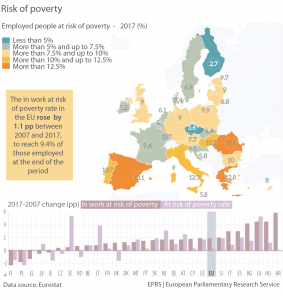The crisis also led to cuts in benefits and a surge in precarious employment, manifested, for instance, by zero-hour contracts and/or low pay. These factors have contributed to an increased risk of poverty among employed people. While this problem concerned an estimated 7.6 % of the workforce in 2007, a decade later almost one in 10 employees was affected. In 23 Member States, the in-work at-risk-of-poverty rate increased during this period, and by more than 4 pp in Bulgaria, Luxembourg, Hungary and Croatia, while it decreased by more than 1 pp in Finland, Poland and in Greece. Furthermore, with the exception of Ireland, those Member States severely affected by the crisis, such as Spain, Greece, Italy, and Portugal, have ratios higher than the EU-average. The crisis also resulted in shrinking per capita income and increased joblessness. At the same time deteriorating government finance led to fiscal consolidation, making it harder for those in need to access benefits and weakening social protection and economic activity. All these factors had repercussions on poverty levels, which have been generally rising since the crisis. In 2017, 85.3 million people, representing 16.9 % of the EU population, were living on an income below the poverty threshold, set at 60 % of the national median income after social transfers. Macroeconomic developments such as a crisis simultaneously affect the average income of households and national median income. The number of countries in the most acute situation, where the at-risk-of-poverty rate was above 20 %, has doubled (from four to eight) between 2007 and 2017. Both, the general at-risk-of-poverty rate and the in-work at-risk-of-poverty rate have increased over the last 10 years, in 22 and 20 Member States respectively.
Risk of poverty
Categories:
Related Articles
Visit the European Parliament page on
Visit the European Parliament page on
We write about
RSS Link to Scientific Foresight (STOA)
RSS Link to Members’ Research Service
Blogroll
Disclaimer and Copyright statement
The content of all documents (and articles) contained in this blog is the sole responsibility of the author and any opinions expressed therein do not necessarily represent the official position of the European Parliament. It is addressed to the Members and staff of the EP for their parliamentary work. Reproduction and translation for non-commercial purposes are authorised, provided the source is acknowledged and the European Parliament is given prior notice and sent a copy.
For a comprehensive description of our cookie and data protection policies, please visit Terms and Conditions page.
Copyright © European Union, 2014-2019. All rights reserved.








Be the first to write a comment.